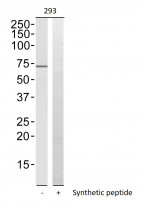ARG66443
anti-NRXN3 beta antibody
anti-NRXN3 beta antibody for Western blot and Human
Overview
| Product Description | Rabbit Polyclonal antibody recognizes NRXN3 beta |
|---|---|
| Tested Reactivity | Hu |
| Tested Application | WB |
| Host | Rabbit |
| Clonality | Polyclonal |
| Isotype | IgG |
| Target Name | NRXN3 beta |
| Antigen Species | Human |
| Immunogen | Synthetic peptide within aa. 30-110 of Human NRXN3 beta. |
| Conjugation | Un-conjugated |
| Alternate Names | C14orf60; Neurexin III-alpha; Neurexin-3; Neurexin-3-alpha |
Application Instructions
| Application Suggestion |
|
||||
|---|---|---|---|---|---|
| Application Note | * The dilutions indicate recommended starting dilutions and the optimal dilutions or concentrations should be determined by the scientist. | ||||
| Observed Size | ~ 70 kDa |
Properties
| Form | Liquid |
|---|---|
| Purification | Affinity purification with immunogen. |
| Buffer | PBS, 0.02% Sodium azide, 50% Glycerol and 0.5% BSA. |
| Preservative | 0.02% Sodium azide |
| Stabilizer | 50% Glycerol and 0.5% BSA |
| Concentration | 1 mg/ml |
| Storage Instruction | For continuous use, store undiluted antibody at 2-8°C for up to a week. For long-term storage, aliquot and store at -20°C. Storage in frost free freezers is not recommended. Avoid repeated freeze/thaw cycles. Suggest spin the vial prior to opening. The antibody solution should be gently mixed before use. |
| Note | For laboratory research only, not for drug, diagnostic or other use. |
Bioinformation
| Database Links | |
|---|---|
| Gene Symbol | NRXN3 |
| Gene Full Name | neurexin 3 |
| Background | This gene encodes a member of a family of proteins that function in the nervous system as receptors and cell adhesion molecules. Extensive alternative splicing and the use of alternative promoters results in multiple transcript variants and protein isoforms for this gene, but the full-length nature of many of these variants has not been determined. Transcripts that initiate from an upstream promoter encode alpha isoforms, which contain epidermal growth factor-like (EGF-like) sequences and laminin G domains. Transcripts initiating from the downstream promoter encode beta isoforms, which lack EGF-like sequences. Genetic variation at this locus has been associated with a range of behavioral phenotypes, including alcohol dependence and autism spectrum disorder. [provided by RefSeq, Dec 2012] |
| Function | Neuronal cell surface protein that may be involved in cell recognition and cell adhesion. May mediate intracellular signaling. [UniProt] |
| Cellular Localization | Membrane; Single-pass type I membrane protein. [UniProt] |
| Calculated MW | 181 kDa |
| PTM | Proccessed by alpha-secretase leading to the formation of an extracellular soluble protein as well as a C-terminal membrane-embedded fragment (CTF). Proteolysis of these CTFs by gamma-secretase releases intracellular domains (ICDs) and extracellular peptides. [UniProt] |
Images (1) Click the Picture to Zoom In






